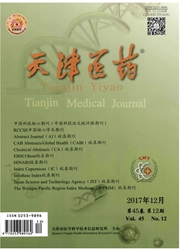

 中文摘要:
中文摘要:
目的 研究大鼠颅脑创伤(TBI)后原位移植神经干细胞(NSCs)治疗的可能性,探讨载有NSCs的纤维蛋白支架及与亚低温(MHT)联合对TBI的治疗作用。方法 从孕14 d SD大鼠皮质组织中分离NSCs,与纤维蛋白支架共培养,应用扫描电镜观察支架及NSCs的形态,并通过免疫荧光检测细胞类型。将48只雄性SD大鼠随机分成TBI组(A组)、TBI+NSC组(B组)、TBI+MHT组(C组)、TBI+NSC+MHT组(D组),每组12只。A组通过液压损伤仪行TBI造模;B组TBI后接受NSCs移植治疗;C组TBI后接受MHT治疗;D组TBI后接受NSCs与MHT联合治疗。分别在第14、28天通过神经功能缺陷评分(m NSS)和水迷宫实验对大鼠进行神经功能评价;28 d后取脑组织切片,行细胞免疫荧光检测,观察移植后的NSCs在体内分化情况。结果 电镜扫描显示,NSCs与纤维蛋白支架共培养3 d后形态无明显改变;免疫荧光提示NSCs特异性标志物Nestin阳性表达,表明神经干细胞在纤维蛋白支架上存活;D组大鼠的m NSS在第14天和第28天均低于A、B、C各组;水迷宫结果显示,D组大鼠逃避潜伏期短于A、B、C各组;D组28 d后脑组织取材可追踪到Brd U标记的神经干细胞分化为了神经元。结论 纤维蛋白支架与NSCs生物相容性良好,具有可降解性。亚低温与载NSCs的纤维蛋白支架对大鼠TBI后的神经功能修复具有协同作用。
 英文摘要:
英文摘要:
Objective To investigate the possibility of therapy method in orthotropic transplant fibrin scaffold mixedneural stem cells (NSCs) after traumatic brain injury (TBI), and combined effects of that fibrin scaffold with mild hypothermia (MHT) on TBI in rats. Methods Neural stem cells were separated from El4 Sprague-Dawley rats, and were co-cultured with fibrin scaffold. Scanning electron microscope was used for observing neural stem cell surface morphology in fibrin scaf- fold, and immunofluorescent staining was introduced for detecting cell types. Forty-eight male Sprague-Dawley rats were randomly divided into four groups: TBI group (A), TBI+NSC group (B), TBI+MHT group (C) and TBI+NSC+MHT group (D). TBI model was built with fluid percussion device in group A. Group B was treated with fibrin scaffold carrying neural stem cells after TBI. Group C was treated with MHT for 6 hours after TBI. Fibrin scaffold mixed BrdU labeled neural stem cells were co-transplanted into cortex damage area of group D and mild hypothermia was given for 6 hours, mNSS (modified neuro- logical severity score) and Morris water maze were examined to evaluate the neurologic function at 14 and 28 days after TBI. The rats were sacrificed at 28 days for brain slices. Immunofluorescent staining was used to examine the migration and differ- ention of NSCs in vivo. Results No obvious morphology changes were observed in NSCs, which were co-cultured in fibrin scaffold. The specific marker Nestin was expressed in detected NSCs by immunofluorescence, which indicated that NSCs were still alive in the co-coture fibrin scaffold. The mNSS scores were significantly lower in group D than those of groupA, B and C at day-14 and day-28 (P 〈 0.05). Results of Mmxis water maze showed that the escape latency was significantly short- er in group D than that of group A, B and C (P 〈 0.05). BrdU labled NSCs was found differentiated into neurons in group D at day 28. Conclusion Fibrin scaffold and NSCs have a good b
 同期刊论文项目
同期刊论文项目
 同项目期刊论文
同项目期刊论文
 期刊信息
期刊信息
